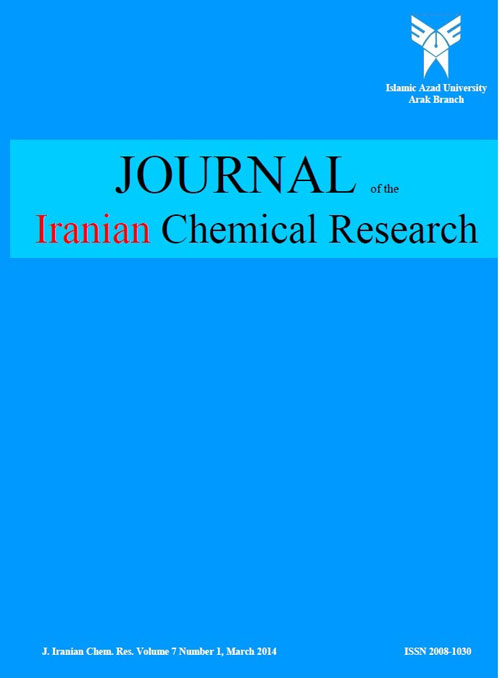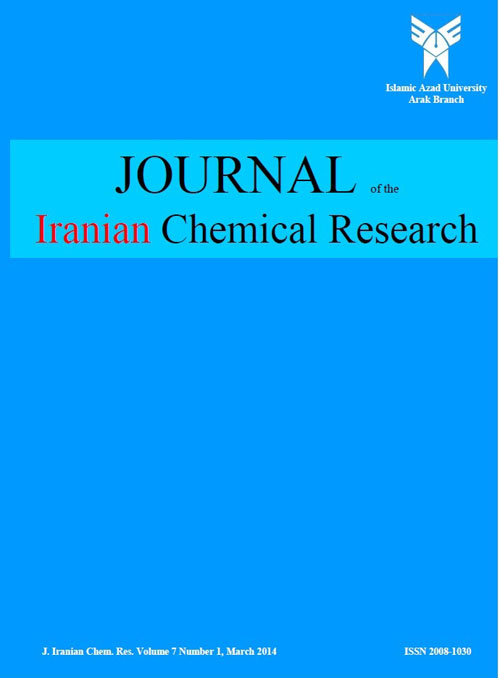فهرست مطالب

Journal of the Iranian Chemical Research
Volume:3 Issue: 1, Winter 2010
- تاریخ انتشار: 1388/12/25
- تعداد عناوین: 8
-
Pages 1-9Partial least squares modeling as a powerful multivariate statistical tool was applied to the simultaneous spectrophotometric determination of silicate and phosphate in aqueous solutions. The concentration range for silicate and phosphate were 0.02-0.6 and 0.4-3 μg ml-1, respectively. The experimental calibration set was composed with 30 sample solutions using a mixture design for two component mixtures. The absorption spectra were recorded from 500 to 900 nm. The optimum conditions were obtained by simplex optimization method. The values of root mean square error of prediction (RMSEP) for silicate and phosphate using partial least squares (PLS) were 0.0017 and 0.02 μg ml-1, respectively. The effects of various cations and anions on detection of silicate and phosphate were investigated. The method was successfully used for determination of silicate and phosphate in boiler water at power plant, well water and sewage samples.Keywords: phosphate, Silicate, PLS, Boiler water, sewage, Simplex
-
Pages 11-15Pure barium zirconate nanopowders were successfully prepared in wet-chemistry synthesis method, using barium stearate and tetra-n-butyl zirconate as Ba, Zr sources and stearic acid as complexing reagent. The gel was calcined at 800 and 900 °C in air. Results of thermal analysis are given, including both DTG and TG. Fourier transform infrared spectrometry (FTIR), X-ray diffraction (XRD), transmission electron microscopy and (TEM) scanning electron microscopy (SEM) were used to characterize the crystallization process, the particle size and morphology of the calcined powders. The results indicated that barium zirconate nanopowders with particle size between 20 and 25 nm could be obtained after calcinations of the dried gel at 900 °C for 2 h.Keywords: Barium Zirconate, Wet, chemistry synthesis, Nanopowders, X-ray diffraction, TEM, FTIR, SEM
-
Pages 17-30In this paper, electronic, structural, and spectroscopic properties of mono-, di-, tri-, and tetrafluorothiophenes and their radical cations are studied using the density functional theory and B3LYP method with 6-311** basis set. Also the effects of the number and position of the substituent on the electrochemical properties of the thiophene ring have been studied using optimized structures obtained for these molecules and their cations, vibrational frequencies and nuclear chemical shielding constants of these compounds have been calculated and analyzed. The results of this study including charge and spin-density distribution, size and direction of the dipole moment vector, ionization potential, electric polarizability and NICS show that among all of these compounds 3-fluorothiophene as candidate monomer for new conductive polymers, possesses the most suitable conditions for electropolymerization.Keywords: DFT, B3LYP, Dipole moment, Fluorothiophenes, Conductive polymers
-
Pages 31-36The multivariate calibration method, partial least square regression (PLS) was applied for the simultaneous spectrophotometric determination of Lidocaine (LID) and Hydrocortisone acetate (HCA) in their mixtures. The parameters of chemometric technique were optimized and the proposed method was validated with synthetic samples and applied to analyze these drugs in pharmaceutical products with good accuracy and precision. The results were compared with the HPLC method. The squares of correlation coefficients (R2) for predicted LID and HCA with the proposed method in test samples were 0.9970 and 0.9964, respectively. The relative standard deviations for commercial products were less than 1%.Keywords: Lidocaine, Hydrocortisone acetate, Spectrophotometric, Multivariate calibration
-
Pages 37-40A new alkaloid (1) and two known compounds (2 and 3) were isolated from the blue-green alga Arthrospira platensis. Their structures were determined on the basis of spectroscopic data. According to the obtained data and values in the literature, the compounds were concluded to be eckol.Keywords: Isolation, structure elucidation, alkaloid, Athrospira platensis, eckol
-
Pages 41-47In this article six new copoly(amide-imide)s (11a-c) were synthesized through the direct polycondensation reaction of 1,3-bis[4,4'-(trimellitimido) phenoxy] propane (6) with 3,3'- diamino diphenyl sulfone (7), 4,4'-diaminodiphenyl ether (8) and 1,5-naphtalene (9) in the presence of fumaric acid (10) as a second diacid in a medium consisting of N-methyl-2- pyrrolidone, triphenyl phosphite, calcium chloride and pyridine. The resulted polymers were fully characterized by means of FT-IR spectroscopy, elemental analyses, inherent viscosity, and solubility tests. Thermal stabilities of a polymer (11a-c) were investigated by using TGA & DTG thermograms.Keywords: High performance polymers, Copoly(amide, imide)s, Direct polycondensation
-
Pages 49-58The use of quantitative structureactivity relationships, since its advent, has become increasingly helpful in understanding many aspects of biochemical interactions in drug research.
This approach was utilized to explain the relationship of structure with biological activity of antibacterial. For the development of new fungicides against, the quantitative structuralactivity relationship (QSAR) analyses for fungicidal activities of Pyrroledione Derivatives were carried out using multiple linear regression (MLR) Quantitative structureactivity relationship (QSAR) analysis was performed on a series of 3-Bromo-4-(1-H-3-Indolyl)-2, 5-Dihydro-1H-2, 5- Pyrroledione Derivatives.QSAR investigations were based on Hansch's extra thermodynamic multi-parameter approach. QSAR investigations reveal that steric and electrostatic interactions are primarily responsible for enzymeligand interaction. These studies produced good predictive models and give statistically significant correlations of selective COX-2 inhibitory with physical property, connectivity and conformation of molecule. Also when available COX-1 inhibitory data was analyzed with descriptors obtained from chem. Office 2007, partial charge descriptor, van der Waals surface area and solvation energy gave statistically significant results. The results obtained by combining these methodologies give insights into the key features for designing more potent analogs antibacterial.Keywords: 2D QSAR, Antibacterial, Staphylococcus aureus -
Pages 59-63Garciniavalline (1), a novel aporphinoid alkaloid, in addition to four known alkaloids, cleistopholine (2), O-methylmoschatoline (3), (-)-oliveroline (4) and (-)-oliveridine (5), were isolated and characterized from Garcinia Parvifolia Miq. stem bark. Structural elucidation of these compounds was established by spectroscopic methods. Among them, alkaloids (2) and (4) exhibited antiplasmodial activity against Plasmodium falciparum.Keywords: Isoquinoline alkaloids, Garcinia Parvifolia Miq, Antiplasmodial


